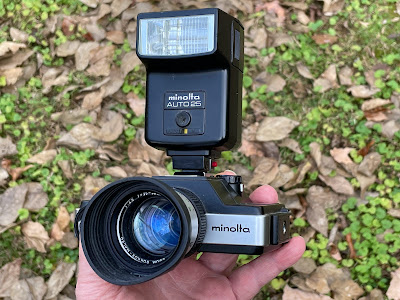The lens is an f/4.5-f/16 25 mm-50 mm zoom macro (roughly equivalent to a 50 mm - 100 mm zoom on a 35 mm camera) with 10 elements in 10 groups. The zoom ring on the lens is marked for 25 mm, 30 mm, 35 mm, 40 mm, 50 mm and macro. The lens focuses as close as 1 meter in the normal focusing range. An 11th lens element moves into place when you turn the zoom ring to the macro setting and the camera then focuses from 30.7 cm to 28.6 cm. The lens takes 40.5 mm screw-on filters. The aperture is manually set by a dial surrounding the CdS light sensor.
A dial sets the exposure mode to "A" (auto), "X" (flash) or "B" (bulb). The dial has a silver latch button to prevent accidentally turning the dial. In auto mode a feeler inside the camera engages a tab on the film cartridge to set the film speed to low (about ISO 100) or high (about ISO 400) and the shutter is electronically timed from 10 seconds to 1/1000 second. Plus or minus 1 to 2 stops of exposure compensation is provided for unusual lighting conditions. In flash mode the shutter is set at 1/150 second. In bulb mode the shutter is open as long as the shutter release is pressed. Flash mode and bulb mode will work without battery power. In a pinch, if the battery runs out exposures can be made outdoors without an electronic flash by setting the mode to "X" and setting the aperture manually for 1/150 second shutter speed. For example, f/11 with 100 speed film on a sunny day.
The shutter syncs with electronic flash at 1/150 second. The camera will not work with flash bulbs. A companion Minolta Auto 25 electronic flash unit was available. A switch on the front of the Auto 25 can be set for manual flash or automatic flash and there is an exposure calculator dial on the back. With flash the exposure depends on the distance to the subject, the power of the flash and the aperture of the lens. The guide number with 100 speed film is 25 meters (82 feet) at the manual flash setting. Guide number divided by subject distance gives the aperture setting for flash. With automatic flash the flash power is controlled by a photocell on the flash unit. The lens aperture is set according to the film speed, for example f/5.6 for 100 speed film or f/11 for 400 speed film. The automatic flash range on the Auto 25 is 0.7 to 4.5 meters (2.3 to 15 feet). The flash unit takes 2 AA dry cells. It will work with any camera having a standard hot shoe.
The viewfinder has a microprism focusing spot in the center, a red overexposure warning light and a yellow warning light for shutter speeds longer than 1/50 second. The magnification is roughly 0.55x with the lens at 25 mm and 1.1x at 50 mm. Because zooming the lens in the normal range does not affect focus, you can zoom to 50 mm for critical focusing and zoom back to 25 mm or any intermediate focal length.
 |
| Light path through the camera. |
The dashed outline shows the extra macro lens element.
Negatives in 110 format are 13 mm high by 17 mm wide on 16 mm film and should be able to produce good prints at least 5" x 7". Fresh Lomography 110 film is widely available and expired, but cold stored, Fukkatsu (Japanese for "revival") 110 film is available from the Film Photography Project.









No comments:
Post a Comment